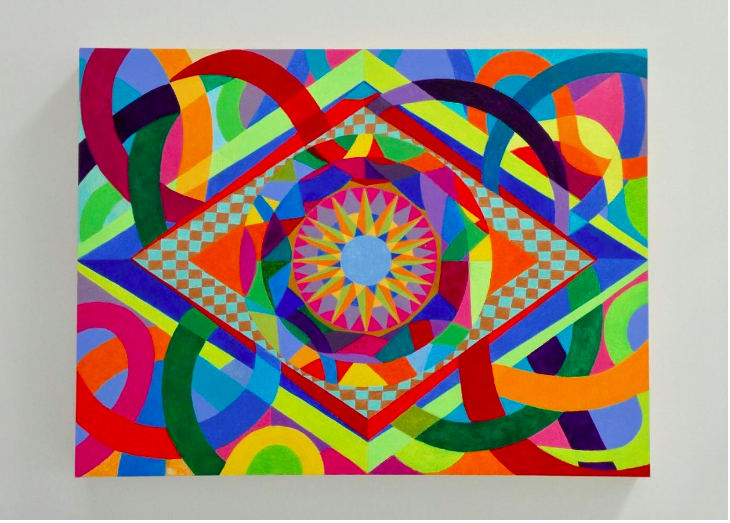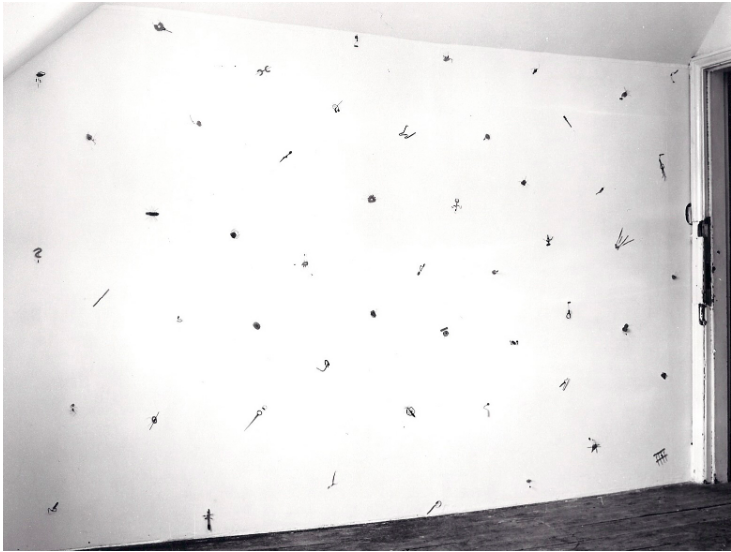Sue Nicholas is a British artist who challenges conventions by diving deep into the complexities of inner consciousness. A graduate of Goldsmith’s College and Imperial College, University of London, her academic background provided a solid base, but her creative path has been anything but traditional. Rather than focusing on outward identity, Nicholas aims to explore the elusive, ever-shifting landscape of the mind. She seeks to represent the fluidity of self, intertwined with the life force that exists within. Her work, primarily composed of vivid polychromatic acrylic and digital paintings, is a testament to her fascination with consciousness and the abstract patterns that shape our existence. This commitment to exploring the uncharted territories of the mind has fueled her creative process, pushing her to experiment with various techniques and methods over the years. Her work invites viewers to engage with their own perceptions, offering a journey into the unknown.

Here is the artist’s interview.
- What is your creative process like?
The starting point of a painting is to focus on my own variable “Thought Patterns” as the context of each painting. This allows me to imaginatively map my own energetic identity as consciousness in the process. How I do this is through “automatic drawing” making a very rough outline in watercolour pencil which is overlayed and developed to create a range of potential options for developing aesthetic decisions. I then start to use paint and colour to particularise the options from the underlying drawing. I look for dynamic rhythms emerging or colliding energetically using line, shape, form, placement in space and a spectrum of colour to shape pulsating abstract patterns. The visual relationships are adjusted and built in many layers of colour and can exist behind, beside or in front of each other, creating interactive episodes that are all in focus and encourage active viewing.
Each work materialises intuitive thought processes, playfully developing, colliding and displacing geometrical and optical formats in colour interactions in space allowing the development of extensive ranges of pattern variations.
The vivid polychromatic acrylic and digital paintings explore and develop a distinctive range of complex rhythmic nonfigurative patterns that are intuitively created by hand. - Do any personal experiences shape your work?
I am inspired by scientific investigations of consciousness which I initially developed in my work as visual “Thought Patterns”. My initial fascination with consciousness was linked to the overlaps between data science, neurological and biological sciences’ attempts to recreate or develop Consciousness through pattern theory and AI. This interest was sparked coincidentally from the early to mid 2000s when in my professional management career I became a Master practitioner in NLP. Simultaneously also in my personal life I developed and practised continually within the universal energy based system of Reiki to Master level. The impact of both NLP and my experience with its ability to remodel and re pattern neural networks within the brain, the potential to change habits, heal trauma, remodel past and model future experiences and change perceptual attitudes together with many experiences from the healing and spiritual modalities of Reiki nurtured my interest in expanding consciousness at the personal and universal level but the expression of that learning and knowing from these two practices found a more natural outlet in my artistic expression in parallel to my experiences from them. Therefore my concern is not with the exploration of persona or outward identity, but in the enigmatic realm of inner consciousness which can only be glimpsed through the imagination or experienced in moments of profound meditation or awareness. The paintings serve as a visual representation of these dynamic complexities, capturing the nuances of mind, soul and the intricate web of neural networks that define our existence which manifests as a vibrant tapestry of thoughts, feelings and sensations all intricately woven together. - What challenges do you face as an artist?
In my formative years at art collage, some of the enduring influences of the time were the Abstract colour field painters, Abstract expressionism as well as Conceptual Art which amplified the contextualisation of the ideas underpinning art, twinned with unorthodox means and methods of
developing individual practices. The vistas across these genres created an expansive territory for exploration and therefore my education at Goldsmiths under Michael Craig-Martins tutelage resulted in my not feeling bound by given frameworks on any level. But feminism was also an overarching influence and at a formative level, I was lucky to have both Mary Kelly and Margaret Harrison as tutors who took an interest in me and my work too. I was also inspired by their different approaches within a rigorous feminist art critique in the 70s and 80s. They paved the way for woman’s art although they did stick within a particular framework of conceptual and political
contexts which I was not bound by as there was a decade or so between us. I graduated with an honours degree in Fine Art in 1980 from Goldsmiths College. Then, I worked as an artist mainly in sculpture/collage for 7 years under my maiden name of Susan Dale and did get into some collections, the most notable being Lady Gibberd who started the Harlow Gallery and the art critic
and writer Guy Brett (recently deceased). My subject matter was concerned with electronics, memory and consciousness as I used a mix of electronic components and other materials to make wall based installations. There were few opportunities for artists in the 80s, as even the Tate Gallery (Now Tate Britain) didn’t invest in much modern art and there was a disconnect between how galleries operated and artists worked as no one openly discussed practical business models or even career development.
So I worked part time in offices to support my practice and rented a space in Wapping with my partner, followed by Hackney Wick both from Space Studios. It was a just get by experience. The art world of the time was incredibly sexist as women artists were seldom taken seriously. Brian Sewell the Evening Standard Art Critic’s famous quote was “There has never been a first rank women artist. Only men are capable of aesthetic greatness” gives a flavour of an aspect of the periods disdain for woman’s’ ability to succeed at the highest level. For the majority of women in the art world there wasn’t so much a glass ceiling but a brick wall. So frustrated with both lack of money and opportunity I reset my life and had a career in Senior Management in the Telecommunications industry which spanned 25 years and involved a lot of strategic modelling, maths, economics and software development. I also gained an MBA.DIC from Imperial College management school in 1995 sponsored by the company. When I entered it in 1986 Telecommunications was a male dominated engineering industry and also initially a sexist environment but there were opportunities for progression. I had to start as a secretary and work my way up, a fine art degree had no cred in that industry. Even senior women managers in London, often were asked in meetings to make tea, as most men tended to assume you were clerical support but that attitude became less prevalent in the mid 90s as society was changing at pace attitudinally across many cultural and political systems. I always remained involved in art though as my peer group outside of work was mainly with artists and gallery social life. I always knew I would return to art but felt a career in a male dominated industry where you had to work very hard to be taken seriously would aid my ability eventually to thrive in the art world as I would acquire the skills to make an impact in this male dominated sphere and I decided a glass ceiling was a better outcome and choice for my ambition than a concrete one. Of course time changes everything and a decade makes a great difference. The mid 90s saw Tracy Emin break through all such restrictions and place the yin and yang of femininity at the centre of art experience. Now women artists have momentum and are are gaining more attention although the amount of women in permanent museum collections at a national level plateaued at around 9%-11% in the last decade. So from the 80s to the present there has been an improvement for Woman artists as woman’s art is very frequently and often noisily discussed to the point that it’s easy to believe they are a mainstream majority but the barriers to entry and success at the major art gallery level are still enormous for most female artists which is statistical verifiable.
I started my practice again in 2018, keeping some of the links in content on consciousness the subject and knowledge of which had evolved because of the development of computing, data, AI and neuroscience but switched instead from sculpture/college installations to painting. I also changed to my married surname of Nicholas to start with a fresh identity and new beginning as I felt it was a rebirth.
What do you want people to feel when they see your art?
When I was eighteen months old, my mother put a harness on me with a rein attached to allow me to walk unaided but within her control. One moment I felt the rein drop to the ground unexpectedly and taking advantage I ran along the pavement as fast as I could to get as far away from being controlled, whilst laughing as I ran. I could hear a cry of anguish and surprise from my mother but the exhilaration I felt and the pure joy of the freedom and independence I was experiencing in that unique moment stayed with me forever and is a metaphor of how I want to negotiate personal space throughout my journey in life. I try to recreate that experience through my work. I want viewers to feel it’s accessible, expansive, inspirational and shows them new possibilities which could equate in some way , at least on an abstract level, to their own lives, taking them out of the pressures of their day to day life experience. My practice is not proscriptive however and the viewer has the freedom to enter it experience it and interpret it in their own way.
Installation 1979. Return of the repressed : Resistance. 2nd yr Goldsmiths Electronic Wire, Copper wire, Resistors, Coloured Wax.
Sue Nicholas continues to explore consciousness and creativity with a passion that has only intensified over the years. Her art remains a dynamic reflection of her fascination with the mind’s complexities, shaped by her experiences in fields as diverse as NLP, Reiki, and telecommunications. By merging scientific curiosity with artistic expression, Nicholas creates pieces that challenge, inspire, and provoke thought. As she forges ahead, her work remains rooted in the quest to represent the unseen and intangible, offering viewers the freedom to find their own meaning within her vibrant, intricate patterns.


